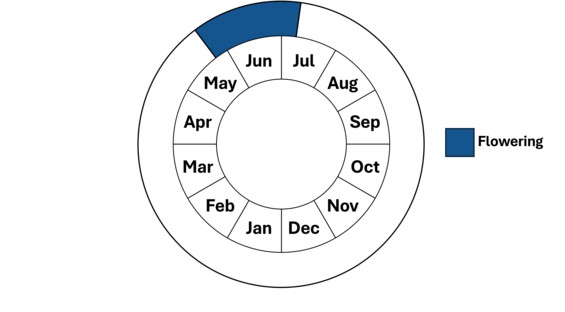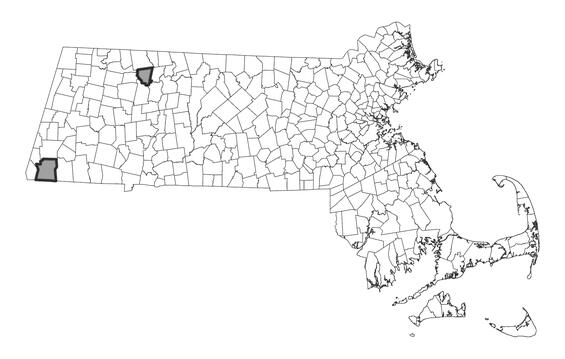- Scientific name: Penstemon hirsutus
- Species of Greatest Conservation Need (MA State Wildlife Action Plan)
- Endangered (MA Endangered Species Act)
Description
Hairy beard-tongue is a light green, erect, herbaceous perennial in the Snapdragon or Figwort family (Scrophulariaceae). The stem is hairy or “hirsute” – hence, the species name hirsutus. Hairy beard-tongue’s stem grows from 4-8 dm (1-3 ft) high and is covered with long, whitish hairs. Its stem-borne leaves are 5-12.5 cm (2-5 in) long, oblong to lanceolate, opposite, stalkless, and finely toothed. A rosette of stalked leaves surrounds the base of the stem. The dull pink, purplish or violet flowers have petals that are partially fused into a narrow, five-lobed floral tube with two upper lobes and three lower lobes. The corolla is about 2.5 cm (1 in) long and ends in white lips. Hairy beard-tongue’s flowers occur in loose, stalked clusters. The fruit is an 8-9 mm (0.3 in) long capsule (a dry fruit derived from a compound pistil that contains many seeds). At maturity, this capsule is more than half covered by the five-parted calyx. Like all members of the genus Penstemon, hairy beard-tongue has five stamens, one of which is sterile and topped by a tuft of hairs in place of an anther. Hairy beard-tongue blooms from late May to early July.
Several non-native species of Penstemon occur in Massachusetts and could be confused with hairy beard-tongue. Foxglove beard-tongue (P. digitalis), unlike hairy beard-tongue, has a smooth stem. Tube beard-tongue (P. tubiflorus) has both a smooth stem and white flowers. Pale beard-tongue (P. pallidus) has leaves that are hairy on both surfaces, while hairy beard-tongue may have a few hairs only on the midvein on the leaf under-side.
Life cycle and behavior
This is a perennial species.

Population status
Hairy beard-tongue is listed under the Massachusetts Endangered Species Act as endangered. All listed species are protected from killing, collecting, possessing, or sale and from activities that would destroy habitat and thus directly or indirectly cause mortality or disrupt critical behaviors. The Massachusetts Natural Heritage & Endangered Species Program has 15 records from 4 counties: Berkshire, Franklin, Hampshire, and Worcester. Two of these records have been observed within the last 25 years. Hairy beard-tongue is also considered rare in Vermont, Quebec, Wisconsin, and Virginia; it was present historically in Delaware. NatureServe ranks hairy beard-tongue as globally apparently secure, G4.
Distribution and abundance
The range of hairy beard-tongue extends throughout northeastern North America from Quebec and Maine to Wisconsin, and south to Virginia and Kentucky.

Distribution in Massachusetts. 2000-2025. Based on records in the Natural Heritage Database.
Habitat
Hairy beard-tongue is a plant of dry or rocky ground in woods, fields, and on hillsides. In Massachusetts, current habitats (1985-2010) include a dry, open but shaded area near limestone quarries; dry, dolomitic lower slopes and walls of two abandoned quarries; and a dolomitic limestone cobble rising abruptly from a river floodplain. Historical habitats in Massachusetts (unverified since 1978) include dry slopes, dry open woods, and dry roadside banks. Associated plant species include various junipers (Juniperus spp.), violets (Viola spp.) and dogwoods (Swida spp.). Yellow oak (Quercus muehlenbergii) and narrow-leaved vervain (Verbena simplex) are two rare Massachusetts species that have been found with hairy beard-tongue.
Healthy habitats are vital for supporting native wildlife and plants. Explore habitats and learn about conservation and restoration in Massachusetts.
Threats
Threats include succession and lack of disturbance to rocky slopes and ledges.
Conservation
Sites containing swamp lousewort should be monitored for over-shading caused by the succession of woody vegetation and/or invasive species. Efforts to remove competitive associated species should strive to not inadvertently eliminate host plants. Some documented host plants of swamp lousewort include: common rush (Juncus effusus), reed canary grass (Phalaris. arundinacea), smooth brome (Bromus inermis), and wool-grass (Scirpus cyperinus). Note that some invasive species (i.e., reed canary grass) are also hosts of swamp lousewort, making the management of heavily invaded areas complicated. Sites should also be monitored for changes in hydrologic regime because swamp lousewort requires occasional, but not persistent, flooding. In Massachusetts, beaver activity may cause local declines in swamp lousewort if beavers flood areas where the plant grows at the time of flowering or seed set.
All active management of rare plant populations (including invasive species removal) is subject to review under the Massachusetts Endangered Species Act and should be planned in close consultation with the MassWildlife’s Natural Heritage & Endangered Species Program.
References
NatureServe. 2010. NatureServe Explorer: An online encyclopedia of life [web application]. Version 7.1. NatureServe, Arlington, Virginia. Available http://www.natureserve.org/explorer. (Accessed: December 17, 2010 ).
USDA, NRCS. 2010. The PLANTS Database (17 December 2010). National Plant Data Center, Baton Rouge, LA 70874-4490 USA.
Contact
| Date published: | May 1, 2025 |
|---|